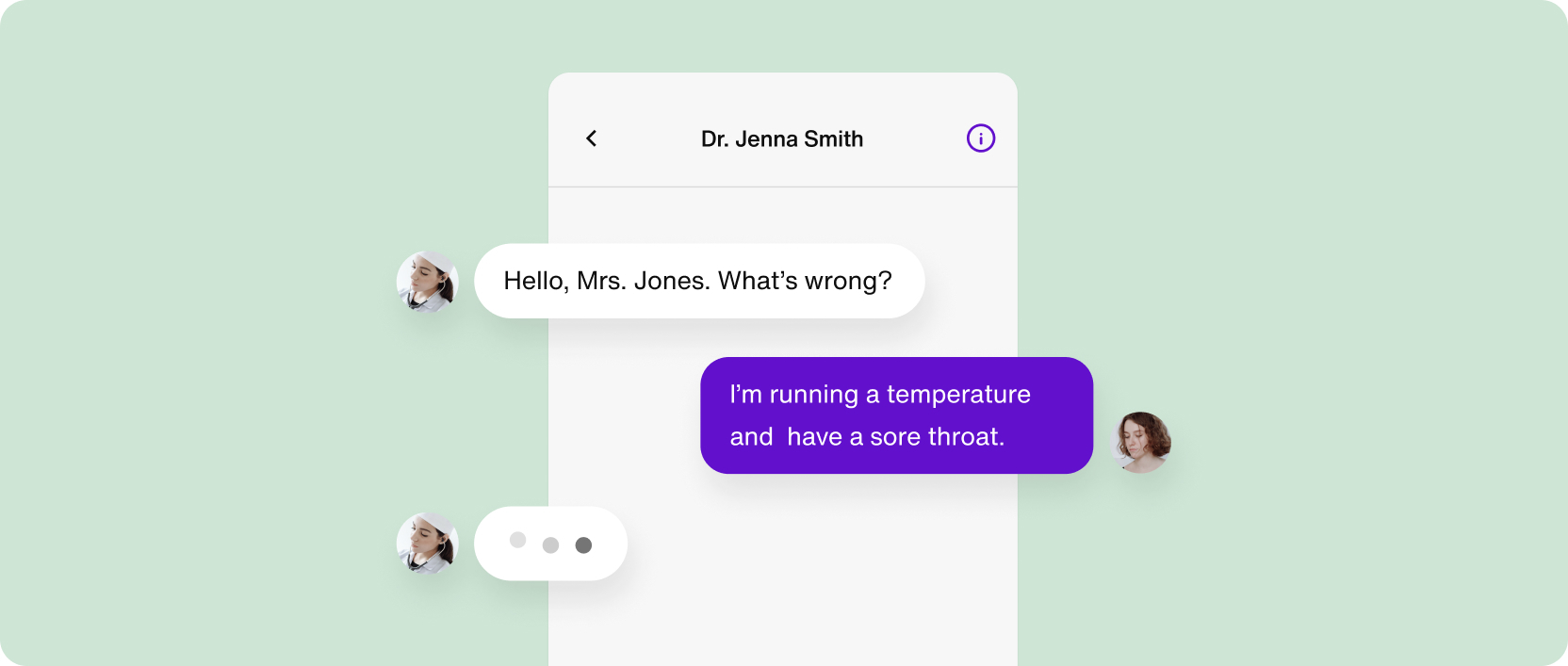9 ways that secure messaging improves patient experiences

As our world evolves, so do the methods we use to meet with healthcare professionals. Go back one hundred years or more; the standard practice was a house call. The doctor would come to your home with a bag of instruments to treat you.
This practice began to decline in the 1940s due to its apparent inefficiencies for doctors.
Unfortunately, the inefficiencies were then transferred over to the patient’s side. To see a doctor, you had to drive to their office, spend an hour flipping through magazines in the waiting room, then be admitted to an examination room where you’d inevitably wait once again.
It has been a highly frustrating part of modern life, but there were few alternatives.
The rise of virtual patients and digital appointments
Thankfully, modern technology has finally removed this burdensome practice for many clinical interactions, making it possible for doctors to make house calls without leaving the comfort of their own office (or home, or hotel, or wherever else they might happen to be). It’s not an exaggeration to refer to virtual care as one of the most significant disruptions in healthcare in the past century.
Healthcare app development is driving this revolution

Mobile technology allows patients to receive medical consultation and care from nearly any location with an Internet connection. Drive times have been eliminated, “office” hours extended, and connectivity is improved.
While the technology in play has been available for years, it took the COVID-19 pandemic to spur widespread adoption. Prior to 2020, less than 1% of the total healthcare volume in the United States was virtual. Given the limited usage, it’s unsurprising that most physicians conducted their first-ever telehealth session during the first months of the pandemic.
But necessity is the mother of invention, and technology has only improved since the flood of usage during the pandemic. Healthcare app development has been supercharged recently, bringing higher patient satisfaction. More importantly, engagement is also increasing. Patients are more likely to take their medicine, follow medical advice, and achieve better results.
It's becoming clear that when resources are more available, patients are more likely to take an active role in their own health. And healthcare apps and other virtual care technology are playing a vital role in the rise of availability.
How secure patient messaging is helping outcomes for virtual patients
Contactless solutions are now the norm in healthcare and are projected to only increase in the coming years. It’s effortless for patients to schedule appointments, receive consultations, refill prescriptions, view their health data, and pay their bills. Rather than driving to and from offices for these functions, patients now have more time for all the other aspects of their lives.
1. Better access to providers
We’ve already discussed the convenience of virtual care and secure patient messaging to all patients. But the impact is most widely felt in regions that don’t have consistent access to quality healthcare. The inequities in healthcare access mean higher mortality rates for those in rural areas. And crucial care, such as prenatal appointments, has often required such long drives that many people simply couldn’t manage.
Virtual care eliminates many of these obstacles. If you live in rural Wyoming and are 200 miles from the nearest hospital, you can still see a doctor anytime you need to. And with secure patient messaging, questions can be answered, and information obtained that doesn't require all the red tape typically associated with a scheduled office appointment.
2. More flexibility in appointments
Speaking of scheduling appointments, virtual care has completely changed the game for healthcare professionals and patients alike. The streamlining of workflows has particularly been impactful on the provider side. Running an office and managing a waiting room full of patients takes time and effort. By moving many of these patients to a virtual setting, the provider can focus more on their primary duties.
Once an appointment is set, reminders can be sent to the patient to improve the likelihood that they will attend. If they need to reschedule, that is efficiently completed within a healthcare app or portal.
3. Feel more comfortable during appointments
The traditional model of in-office appointments has never been a good fit for all patients. Some people felt stressed in such a public and enclosed space, especially knowing that others around them were sick. Others were reluctant to attend appointments due to social stigmas related to their health conditions.
Modern patient communications alleviate these challenges because patients can stay connected to providers without the necessity of leaving the house. In this regard, the convenience and privacy afforded by a healthcare app or provider portal is an absolute game-changer.
4. Less of a financial burden
The first issue is that many patients struggle to find reliable transportation to and from appointments. The gas costs can add up if they own their vehicle and a long drive is required. If they don’t own a vehicle, paying for a taxi or other service is even more expensive.
Another point to consider is that regular office hours for most doctors are usually concurrent with their patients’ work schedules. So attending an appointment could come at the expense of their job and compound the financial burden.
Thankfully, virtual care often eliminates the need for travel or missed work. Patients can video call or exchange messages from any convenient location.
5. Better attendance at follow-up appointments
Given the difficulties many patients face in attending a single healthcare appointment, it’s no wonder that the issues were only compounded for follow-up care. Patients often didn’t attend these appointments, leading to negative outcomes.
The ease of virtual care and patient communications is a welcome remedy. And thanks to scheduling nudges and appointment reminders, there are plenty of opportunities for people to take action. Fewer no-shows are always a positive sign for patients taking an active role in their own healthcare.
6. More likely to continue treatments
The notifications and nudges sent through a healthcare app to virtual patients do more than just help get appointments on the books. They also help make sure patients understand their treatment details and remember to take the required steps.
This is a huge benefit, as many patients struggle to stay on track with their treatments.
For example, patients recovering from surgery could get recurring notifications on their phone about which medications they need to take. If the patient is vigilant with their medications, there’s less of a chance that their condition will worsen and they’ll require more intensive care. And if they do encounter concerns, they can message their provider and receive real-time advice.
7. Easier to manage chronic conditions
Managing chronic conditions can be complex, so patients with such conditions stand to benefit the most from virtual care. They’ll have consistent connections with medication scheduling, appointment reminders, and other helpful features that come with healthcare app development.
Additionally, this technology gives patients better access to their own healthcare data. This allows for more comprehensive care, as patients work with their various providers to monitor symptoms, regulate medications, and develop the best treatment plans.
8. Helps facilitate better patient data
Virtual care is all about data, as connectivity from multiple sources is securely stored and appropriately shared. Devices can track blood pressure, pulse, heart rate, hormonal levels, and more. And when such data improves, outcomes follow suit.
A major benefit of this consistent data collection is that doctors can make diagnoses and treatment decisions based on data from extended periods, rather than just using a snapshot obtained during an in-office appointment. Months and years of data provide clearer pictures and help deliver better outcomes.
This long-term approach to healthcare is aided by patient communications, as patients and doctors can message each other with questions, updates, and suggestions.
9. Deliver patient education resources
Another asset for better patient outcomes is education. Providers can use secure patient messaging to connect their patients with relevant resources when needed. For example, if a patient has recently received a major diagnosis, they will likely want to learn as much about it as possible. Rather than have them spend hours on Google exploring rabbit holes, a doctor could send them quality resources approved by the healthcare community.
Other examples of resources sent through a healthcare app include medication information, checkers for drug incompatibility, and research journals.
When patients have access to accurate and understandable resources, they’re better able to take proactive steps for their health.
Elevating your practice’s offerings is crucial
Modern patients have come to expect the offering of virtual care, so if a practice doesn’t offer it they could easily lose out on patients to the competition. You simply have to stay at the forefront of virtual offerings, or you’ll be left behind.
And it’s not just an issue of convenience and patient outcomes. Through healthcare app development, you can also make things better for the staff. Healthcare providers will have more flexibility in their schedule, the opportunity to work remotely, and enjoy lower overhead expenses. Likewise, office staff will have scheduling burdens lifted and won’t need to take as many calls.
In an industry where burnout is affecting many professionals, these benefits can’t be ignored.
Sendbird makes it easy to stay connected
With Sendbird’s healthcare tools, you can effortlessly deliver streamlined patient care with HIPAA-compliant in-app conversations. These patient-centric communications provide personalized experiences and engage patients at every stage of their healthcare journeys.
Sendbird makes it easy for teams from any office or organization to manage multiple conversations and build lasting loyalty. It’s the most effective way to get better outcomes. Start today by trying Sendbird for free. You’ll have access to all the user-friendly tools needed to elevate your patient communications and enjoy better outcomes for everyone involved.










